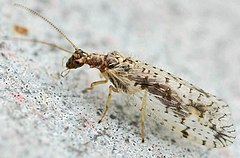Hemerobiidae
| Brown lacewings Temporal range: Jurassic–Recent |
|
|---|---|
 |
|
| Micromus variegatus adult (Microminae) | |
| Scientific classification | |
| Kingdom: | Animalia |
| Phylum: | Arthropoda |
| Class: | Insecta |
| Order: | Neuroptera |
| Suborder: | Hemerobiiformia |
| Superfamily: | Hemerobioidea |
| Family: |
Hemerobiidae Latreille, 1802 |
| Subfamilies | |
|
10, see text |
|
| Synonyms | |
|
Promegalomidae |
|
10, see text
Promegalomidae
Hemerobiidae is a family of Neuropteran insects commonly known as brown lacewings, comprising about 500 species in 28 genera. Most are yellow to dark brown, but some species are green. They are small; most have forewings 4-10 mm long (some up to 18 mm). These insects differ from the somewhat similar Chrysopidae (green lacewings) not only by the usual coloring but also by the wing venation: hemerobiids differ from chrysopids in having numerous long veins (two or more radial sectors) and forked costal cross veins. Some genera (Hemerobius, Micromus, Notiobiella, Sympherobius, Wesmaelius) are widespread, but most are restricted to a single biogeographical realm. Some species have reduced wings to the degree that they are flightless.Imagines (adults) of subfamily Drepanepteryginae mimic dead leaves. Hemerobiid larvae are usually less hairy than chrysopid larvae.
Hemerobiids, like chrysopids, are predatory, especially on aphids, both as larvae and adults. The species Micromus tasmaniae is bred for biological pest control.
The relationships between the Hemerobiidae and the other Neuropteran families are still unresolved. Despite their superficial similarity to chrysopids, the brown and green lacewings may not be as closely related as was at one time believed. Rather, the Hemerobiidae appear to be closely related to the Mantispidae.
The superfamily Hemerobioidea is currently restricted to the Hemerobiidae. Formerly, the pleasing lacewings (Dilaridae), silky lacewings (Psychopsidae), giant lacewings (Polystoechotidae) and as noted above the green lacewings (Chrysopidae) were placed therein too. Of these, only the Dilaridae and Chrysopidae seem to be reasonably close relatives of the brown lacewings. The Psychopsidae in fact seem to belong to an altogether different suborder of Neuroptera, the Myrmeleontiformia.
...
Wikipedia
